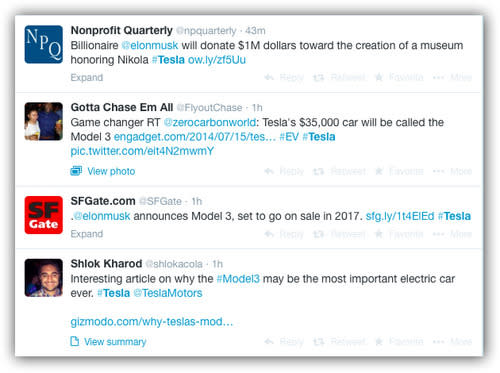Deconstructing Twitter
Deconstructing Twitter
If you remember being a little baffled by Twitter the first time you tried it, you’re not alone. It is baffling.
Sometimes, you can understand everything in a tweet, like this one:

But other tweets are filled with codes and shorthand and weird formatting—that nobody bothers to explain.
Until today.
Before we dive in, though, remember that a tweet can’t be more than 140 characters long. (Why? Because in Twitter’s original conception, tweets were intended to arrive on cellphone as text messages. And those are limited to 160 characters. The Twitter inventors reserved 20 characters for the Twitter member’s name.)
That limitation forces people to be concise, to be creative—and, sometimes, to develop these complex conventions.
Suppose, for example, that you see a tweet like this:

This single example contains four examples of Twitter conventions:
• @SFGate. The @ symbol indicates a Twitter member’s name. I’m @pogue, for example. This tweet also mentions Elon Musk, the CEO of Tesla Motors. His Twitter name is, of course, @elonmusk.
• RT @SFGate. RT stands for retweet. So Debbie here is repeating (that is, retweeting)somebody else’s tweet—in this case, she’s retweeting something @SFGate said. (SFGate is the online edition of the San Francisco Chronicle.)
People use RT as a courtesy; it’s giving credit to the original author.
• sfg.l/1t4EIEd. That’s a URL—a link to a Web page. URLs are super common in tweets, since one key use of Twitter is sharing things found on the Web. Here, if you clicked the link, you’d go to the SFGate article that’s being quoted here.
And why doesn’t it look like a normal Web address? Because, of course, of that 140-character limit. Web addresses are often so long, they eat up your allotment of Twitter characters. So people use link shortening services like bit.ly and goo.gl (yes, those are actual Web addresses, too!). At this sites, you paste in your long address, and it spits out a much shorter one (that points to the same place) to use on Twitter.
Some Twitter programs do that shortening automatically, saving you a step.
• #Tesla. The # is a hashtag. It’s a label for your tweet. Other people can search for these hashtags—or click them—to see more tweets on the same subject. If you click on #Tesla, you’ll see a whole list of tweets, all pertaining to the Tesla company and its cars. (You can also go to Twitter.com and type the hashtag into the Search box.)

That, at least, is the serious function of hashtags.
Nowadays, though, people add hashtags sarcastically, as comments their own tweets. Someone might tweet, for example, “Woman sues restaurant for serving her too big a portion of lasagna. #killmenow.”
Which means: “Oh, my god, I don’t want to live in a society where this can happen; kill me now.)
All right then: Now you can put together what’s happening in this tweet:

In an SFGate article, Tesla Motors founder Elon Musk announced that there’s going to be a new Tesla car, called the Model 3. Twitter member Debbie Duncan passed along a link to the article to her followers (RT), adding the hashtag #Tesla for context and searchability. And she added her own comment to the news flash, saying, “My next car!”
Get it?
Now, here’s an advanced course:

This tweet contains many of the same elements; again, it’s a comment on an article. In this case, you’re seeing the less common abbreviation MT, meaning “modified tweet.” There wasn’t room to include the entire headline (originally tweeted by @BrandonMSellers), so Bill Hewson shortened it and admitted doing so.
(Another baffling one you may see: HT. It stands for “hat tip," which means you’re thanking someone for an idea that became your tweet.)
Then comes the link to the article, and a helpful note that the article comes from the Harvard Business Review. (It, too, has a Twitter account—@HarvardBiz.)
And now you’re ready to understand the seething dialogue that is Twitter, and maybe even to use some of these conventions yourself.
Go forth and tweetify!
